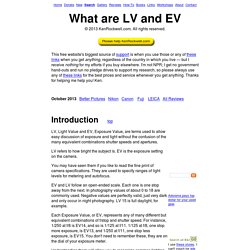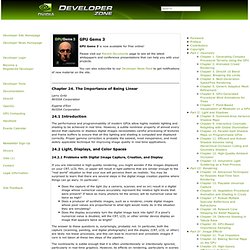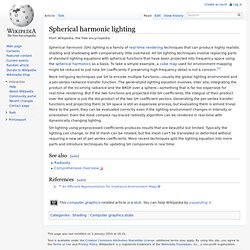

Fundamentals.
Andrew Whitehurst . Net. The Old Fashioned Approach Matching lighting which is part of a photographed background is a staple art of Technical Directors and FX artists.

Whilst techniques such as using ambient occlusion and HDRI are now commonplace in visual effects production it's worth knowing how to tackle this problem when such tools are not available. The "traditional" way of matching lighting in a photographed plate is an art more than a science and hopefully the techniques I present here will merely begin to get you thinking along the right lines when you have to tackle such an assignment.
It will take a lot of practice to be able to convincingly match real world lighting. This technique uses no raytracing, no Global Illumination and no HDRI. OK, so how do we tackle this problem? Scene black levels Film and video seldom represent true black in their images. Ambient light lifts the blacks. Andrew Whitehurst . Net. Resource This is a repository of scripts, small pieces of code, shaders etc. that you may find useful.

You use anything from here entirely at your own risk. MEL scripts: Light Manager offers Maya artists a quicker more intuitive interface for handling multiple lights simultaneously. The online docs are here. Python scripts: imgDetails is for those who like to write their HTML in a text editor the old fashioned way. Lseq is a sequence lister written in Python and designed to be used in a Unix-style terminal (Unix, Irix, Linux, Mac OS X etc.).
Lookdev MasterClass 2012.
Adjusting lights in arnold - fxphd lounge. UeberTage 2010" (Part I) The Art of Rendering (updated) Using HDR Images for 3D Lighting in Maya Tutorial. Vray. What are EV and LV © 2005 KenRockwell.com. Home Donate New Search Gallery Reviews How-To Books Links Workshops About Contact What are LV and EV © 2013 KenRockwell.com.

All rights reserved. This free website's biggest source of support is when you use those or any of these links when you get anything, regardless of the country in which you live — but I receive nothing for my efforts if you buy elsewhere. I'm not NPR; I get no government hand-outs and run no pledge drives to support my research, so please always use any of these links for the best prices and service whenever you get anything. Exposure value. Fast shutter speed, short exposure of a water wave.

Slow shutter speed, long exposure of the wave. The EV concept was developed in an attempt to simplify choosing among combinations of equivalent camera settings, by the German shutter manufacturer Friedrich Deckel (de) in the 1950s (Ray 2000, 318). Exposure value was originally indicated by the quantity symbol ; this symbol continues to be used in ISO standards, but the acronym EV is more common elsewhere. Although all camera settings with the same EV nominally give the same exposure, they do not necessarily give the same picture. Formal definition[edit] Extended exposure time of 26 seconds. Light and Exposure Values (LV & EV) Light Value (LV) and Exposure Value (EV) are numerical scales for measuring the amount of light, and the exposure, respectively.

These are often confused - not least by the labeling on some cameras; the difference is that LV measures how much light there is, and EV measures how much of the light is allowed into the camera. The scale is logarithmic- that is, each step up on the LV scale is twice the amount of light, and a step up on the EV scale correspondingly halves the exposure.
Typical values of LV in daylight vary between about 16 (extremely bright sun), down to around 10 (dark clouds) and of course, lower in very bad weather, at night or indoors. For most purposes, a range of (say) 2 to 18 covers most conditions where the photographer can still see their subject. Many light meters are not sensitive enough to reach even this range, although for some special purposes (such as astronomy) values beyond this range may be required. where Link Edit. EV vs. f-stop - Photography QnA at BetterPhoto. Tim,The answer is YES.

Community - Forums. Hi Michal, for several reasons.

In film we match the light of the plates(real footage)(and also reference spheres like chrome spheres and grey spheres) to the 3D elements. In the plates we measure this light in exposure(stops), so when you are lighting you can exactly match the light of the 3D elements against the plates by increasing/decreasing one stop, half a stop, etc. This makes the workflow more accurate. Also, for reflection lights and environment lights, because we use HDRi textures on them, you can increase/decrease the exposure(stops) of the light, and it will match with the HDRi texture exposure.
So, if the VFX Supervisor tells you, that lighting is good but increase the ambient half a stop, you know that you are actually correctly measuring the light and then matching it accordingly. I hope this makes sense. GPU Gems 3 - Chapter 24. The Importance of Being Linear. GPU Gems 3 is now available for free online!

Please visit our Recent Documents page to see all the latest whitepapers and conference presentations that can help you with your projects. You can also subscribe to our Developer News Feed to get notifications of new material on the site. Chapter 24. Spherical harmonic lighting. Spherical harmonic (SH) lighting is a family of real-time rendering techniques that can produce highly realistic shading and shadowing with comparatively little overhead.

All SH lighting techniques involve replacing parts of standard lighting equations with spherical functions that have been projected into frequency space using the spherical harmonics as a basis. To take a simple example, a cube map used for environment mapping might be reduced to just nine SH coefficients if preserving high-frequency detail is not a concern.[1] More intriguing techniques use SH to encode multiple functions—usually the global lighting environment and a per-vertex radiance transfer function.